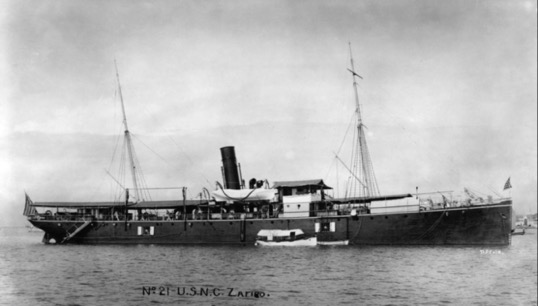Zafiro

The build
The Zafiro was built by the Hall Russell company in Aberdeen for the China and Manila Steamship company to operate a service between China, Hong Kong and the Philippines.
The 1,062grt ship had a loa of 220ft and as powered by two large boilers feeding compound surface condensing engines developing 200hp and driving a single screw, the Zafiro was capable of 12.5 knots. It was regarded as a fast and luxurious vessel carrying up to 30 first class and 300 second class passengers, as well as cargo.
In 1917, the Zafiro changed ownership and underwent a series of modifications, including the re-arrangement of the original two-master brigantine rig and fitting a new 250hp Atlas Diesel engine.
Ownership
In April 1898, the Zafiro was bought by the US Navy for service as a collier and supply ship and stayed with the US Navy until it was sold to Mr J.W. Zeeve of Seattle, Washington in 1910, who quickly sold the Zafiro to the Mexican government.
In 1917, the Zafiro was passed on to Canadian owners and was renamed Bowler. In the same year, Panama passed legislation establishing its new ship registry, with no restrictions on the nationality of owners and crew.
Two years later, on 20 August 1919 under new ownership the Bowler was renamed Belén Quezada and switched to the Panamanian flag as part of a scheme to smuggle alcohol to the US during Prohibition – although the ship was never caught ‘rum-running!’
Zafiro Fact File
How big was the Zafiro?
The Zafiro had a grt of 1,062grt.
How many times was the Zafiro renamed?
The Zafiro was renamed twice to Bowler in 1917 and to Belén Quezada in 1919.
When did the Zafiro switch to the Panama flag?
The Zafiro switched to the Panama flag in August 1919.
Incidents and legal disputes
The Zafiro sailed from Aberdeen in February 1884 under the command of local shipmaster Captain Robert Maitland Talbot, and arrived in Hong Kong on 8 May 1884. The ship – which ran with British officers and Chinese ratings – was involved in two grounding incidents on the Chinese coast in 1885 and 1894.
Under the ownership of the US Navy, the Zafiro initially continued to sail with British officers, who were nominally under the command of a US Navy officer. This gave the initially unarmed vessel neutral status while supporting operations around the Philippines during the Spanish-American War.
This status was later the subject of a 1925 court case, in which it was ruled that the US was responsible for the actions of the converted merchant ship and its crew under the terms of the Hague Convention.
From mid-1899 to June 1904, the Zafiro was used to support US forces during the Philippine-American War.
The Zafiro was decommissioned in 1904 and was due to be sold in 1906, but went on to spend a few years as a cable store ship before it was sold to Mr J.W. Zeeve.
Finally, the vessel was confiscated by Costa Rica during a border conflict with Panama in 1921, and was eventually scrapped in Guayaquil in 1925.
Contribute
Are you knowledgeable about this vessel?
Submit your contribution to this article to our editorial team.
Write to usView more ships of the past
HMS Beagle
Launched 200 years ago, HMS Beagle has been described as one of the most important ships in history – thanks to the observations on evolution and natural selection that its famous passenger Charles Darwin made during a five-year voyage around the world between 1831 and 1836.
Common.ReadMoreHMS Beagle
Manchester Challenge
Launched in June 1968, Manchester Challenge was one of the first British-built and operated cellular containerships, and it entered service in November that same year.
Common.ReadMoreManchester Challenge
Esso Ulidia
Delivered in October 1970, Esso Ulidia was one of eight 250,000dw-plus ships, which were all named after old British and Irish kingdoms, to be constructed for Esso's red ensign fleet between 1969 and 1973.
Common.ReadMore